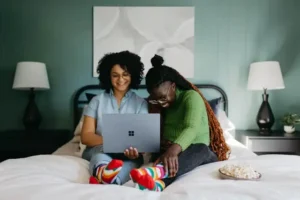Parenting in the digital age requires a delicate balance. Non-invasive parental control is crucial for guiding children without stifling their independence. It’s about subtle supervision, ensuring their safety while respecting their privacy.
In today’s digital world, finding the right mix between keeping kids safe online and respecting their privacy is more important than ever. Children need room to explore, but parents must also protect them from online risks. This balance is the key to fostering trust and ensuring well-being.
Android offers a suite of tools designed for subtle parental guidance. These features allow parents to monitor activities discreetly, set boundaries, and ensure a safe digital environment without feeling intrusive. By using these tools, parents can maintain oversight without micromanaging and promote a healthy and respectful relationship.
What is Non-Invasive Monitoring?
Non-invasive monitoring means keeping an eye on your child’s digital activities without hovering. It requires setting up safety nets that let them explore freely while staying within safe boundaries. Think of it as digital hand-holding, where you’re always there, but not in their face.
This form of guidance helps children develop a sense of responsibility and independence. It encourages them to make good choices without feeling constantly watched. This approach supports their growth into confident and capable digital citizens, who are ready to navigate the online world wisely.
Trust is the cornerstone of any relationship, and it’s especially crucial in digital parenting. By practicing monitoring that doesn’t feel invasive, you show your kids that you trust them. This, in turn, creates open communication, making it easier for them to come to you with concerns or questions.
Regularly discussing online experiences and potential risks helps kids feel understood and supported. Instead of feeling policed, they’ll feel guided and empowered. This ongoing dialogue builds a healthy digital environment where they feel safe and respected.
Discover Android’s Unseen Forces
Android’s Family Link is a game-changer for parents. This app offers features to keep kids safe without feeling like a digital helicopter parent. It’s designed to blend into the background, giving you peace of mind while letting your child explore the digital world.
Setting up Family Link is a breeze. Download the app, create a Google account for your child, and link it to yours. This straightforward process ensures you’re not being intrusive while establishing a safety net. It’s akin to setting up a guardian that keeps an eye on things.
One standout feature is screen time management. You can set daily limits and even a bedtime for devices. This helps instill healthy digital habits without constantly nagging your child to put the phone down. It’s a smart way to encourage balance and discipline.
Curious about what apps your child uses? Family Link also provides detailed app activity reports. This lets you see where their time goes without spying. Plus, you can approve or block apps, ensuring they’re using age-appropriate content.
Even for those moments when you need to know where your child is, Family Link’s location sharing feature has you covered. It shares their device location with you, providing reassurance without prying.
Setting Smart Screen Time Limits
Start by setting reasonable screen time limits. Consider their age, school schedule, and extracurricular activities. A good rule of thumb is to balance screen time with other activities. This way, they can enjoy their digital world without it taking over their entire day.
Encouraging healthy digital habits doesn’t have to be a struggle. Make screen time a reward for completing homework or chores. Use it as an opportunity to bond by watching educational content together. This approach promotes positive behavior without feeling like a strict enforcer.
As your child grows, their screen time needs will change. Regularly review and adjust settings to reflect their age and responsibilities. Gradually increasing their screen time allowance as they mature helps them learn self-regulation. It’s like giving them digital training wheels that you can loosen over time.
Flexibility is also key to using screen time management effectively. Allow some extra screen time on weekends or special occasions. This flexibility shows you trust their judgment and helps them understand the importance of balance. Finding a routine that keeps everyone happy and balanced makes all the difference.
Monitoring App Usage
Utilizing app activity reports can give you a clear picture of your child’s digital habits. These reports show which apps they use and for how long. This knowledge helps you guide their app usage and ensure they benefit from their screen time without overindulging.
When discussing app usage with your child, focus on being constructive. Ask them about their favorite apps and why they enjoy them. This opens a dialogue, making it easier to share your concerns. Through this, you have the opportunity to connect rather than correct and build a supportive environment.
If you notice something worrying, address it without invading their privacy. For instance, if they’re spending a lot of time on a game, suggest exploring educational apps together. Or, if a particular app seems inappropriate, explain why and discuss alternatives. Don’t forget: you’re there to guide, not to police.
Maintaining a balance between freedom and supervision is very important. Use app activity reports to ensure your child’s digital diet is healthy and varied. By monitoring subtly and discussing openly, you can help them make smarter choices while respecting their independence.
Encouraging Responsible Digital Behavior
Another thing parents should not forget is encouraging self-regulation and accountability in digital behavior. Start by setting clear boundaries and expectations. Discuss with your child why these limits are important. This empowers them to make responsible choices and understand the value of balanced screen time.
Always involve your child in setting up guidelines and expectations. When they have a say, they’re more likely to follow the rules. Collaboratively decide on screen time limits, types of permissible apps, and digital curfews. This shared approach fosters a sense of ownership and cooperation.
Rewarding positive digital habits and behaviors reinforces good practices. Praise your child when they adhere to screen time limits or choose educational apps over games. Consider a reward system where they earn extra screen time for responsible behavior. It’s a fun way to motivate and encourage healthy habits.
Consistency in enforcing guidelines and rewards ensures that the strategies are effective. Regularly review and adjust the rules as needed, keeping communication open. This consistency helps in building a routine that supports responsible digital behavior, making everyone’s digital experience safer and more enjoyable.
Educational Apps as Tools for Engagement
Educational apps can turn screen time into learning time. Apps like Khan Academy Kids promote learning and creativity. These tools make education engaging and interactive, helping children develop essential skills while having fun. It’s a win-win for both parents and kids.
Using fun apps to engage children allows you to monitor activity without being intrusive. Games that teach problem-solving or enhance cognitive skills can be both entertaining and educational. Apps like Minecraft: Education Edition blend fun and learning seamlessly, keeping your child engaged constructively.
Balancing educational content with entertainment is crucial. Ensure your child’s app usage includes a mix of learning tools and fun activities. This balance keeps them interested and prevents screen time from becoming monotonous. It’s all about creating a varied digital diet that nourishes both mind and spirit.
Explore new apps together with your child. This not only ensures the content is appropriate but also makes the experience enjoyable for both of you. Sharing these moments builds a positive relationship with technology and shows your child that screens can be gateways to knowledge and creativity.
Open Communication
Regular conversations about digital safety are crucial for non-invasive guidance. Make these talks a part of your routine, like discussing their day at school. This ensures your child understands the importance of staying safe online and knows you’re there to help them navigate any challenges.
To create an environment where children feel comfortable sharing, be approachable and non-judgmental. Encourage them to talk about their online experiences, both good and bad. Show genuine interest and listen actively. Through this openness, you can help them feel safe to discuss any issues they might encounter.
When addressing digital issues, avoid causing friction by being calm and understanding. Instead of reprimanding, ask questions to understand their perspective. Offer guidance and suggest solutions collaboratively. This approach helps maintain trust and ensures they feel supported rather than criticized.
Keeping an ongoing dialogue is also very important. Regularly check in with your child about their digital activities and experiences. This continuous conversation helps you stay informed and keeps the lines of communication open. The goal is to make sure your child knows they can talk to you anytime.
Evolving Parental Controls
As children grow, adjusting parental controls becomes something you must pay attention to. Gradually relax restrictions as they demonstrate responsible behavior. This helps them feel trusted and prepares them for more independence. Start with small changes, like extending screen time or allowing new apps, to match their maturity level.
Encouraging independence while maintaining safety is a balancing act. Give them opportunities to make decisions, like choosing their apps or setting their own screen time limits within your guidelines. This builds their confidence and decision-making skills, while you still keep an eye on their overall digital activity.
Planning for the transition to self-regulation should be a part of your long-term plan. Set clear expectations and gradually shift responsibility to your child. Discuss potential challenges and how to handle them. This ongoing guidance helps them develop self-discipline and prepares them for a future where they manage their own digital life.
Using a trust-based approach fosters a sense of accountability. Celebrate their successes and provide constructive feedback when needed. This reinforces their positive behaviors and encourages them to continue making wise choices. The goal is to help them grow into responsible digital citizens, ready to navigate the online world independently.
Conclusion: Subtle Yet Effective
Non-invasive parental guidance is vital for a healthy digital environment. It ensures your child’s safety without compromising their independence. By adopting monitoring techniques that are subtle, you can guide their online journey effectively while maintaining trust and open communication.
Android’s parental control tools offer a practical solution to balance safety and privacy. Features like Family Link, screen time management, and app activity reports provide oversight without feeling intrusive. These tools help you create a secure digital space where your child can explore and learn confidently.
Encourage a supportive and informed approach to digital parenting. Stay engaged with your child’s online activities, adjust controls as they grow, and maintain an open dialogue. By embracing these strategies, you’ll help them develop into responsible digital citizens, ready to be a citizen of the online world with confidence and care.





